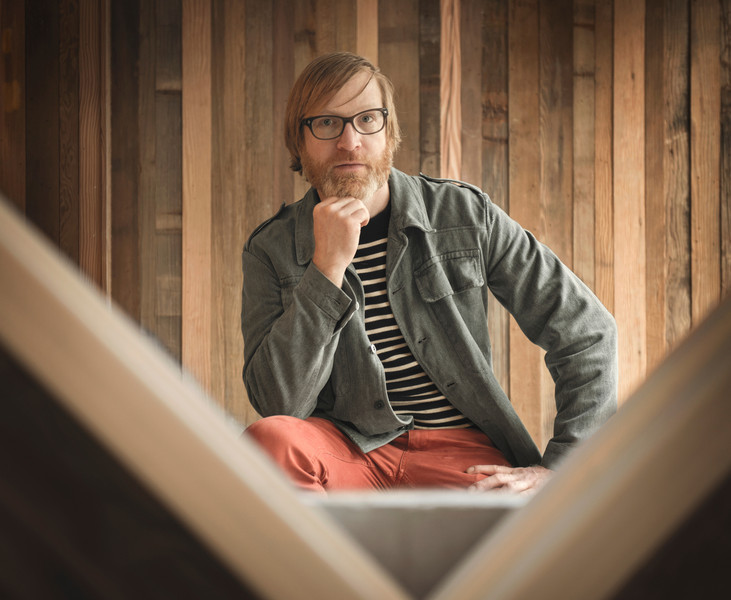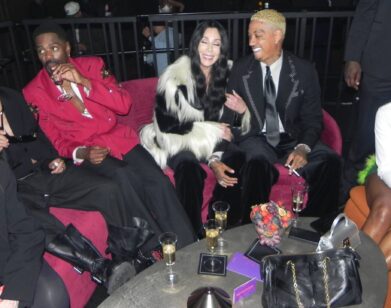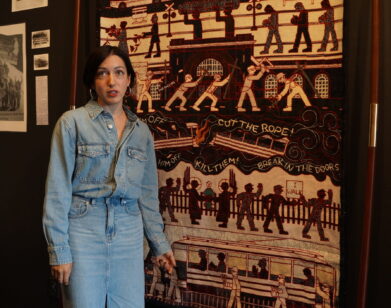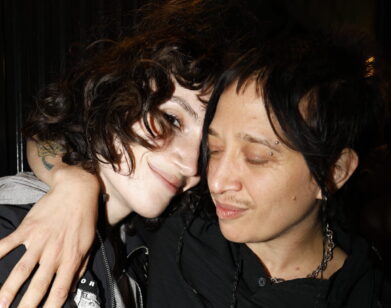Burning up the Kitchen

ABOVE: DANIEL BURNS. IMAGE BY CHRISTOPHER GABELLO
After graduating college with degrees in mathematics and philosophy, Daniel Burns turned to cooking when he realized that high-school math teacher was not his dream job. Like many a North American chef before him, Burns relocated to Europe, for an intense, hands-on education. He worked at two London restaurants, The Fat Duck, as the pastry chef, and St. John, picking up the finer points of butchery, before winding up at Noma in Copenhagen, where he established the pastry program. During his three years there, he saw Noma become one of the top restaurants in the world.
Back stateside in New York, Burns headed the test kitchen at David Chang’s Momofuku restaurant empire. His mathematics background “didn’t hurt,” he admits when it came to precision, but as he describes his invention of Momofuku’s shiitake chip, we get the feeling his capacity for abstract philosophical thought helped as well. While trying to concoct a new broth, he realized flavor was getting caught in the strainer. Of course. So, he dried out the strainer sludge (really), and found it formed a brown, porous chip, that happened to taste incredible.
Now, having mastered both the sweet and savory realms of the kitchen, Burns, finally, is setting up on his own. This spring he opens his first restaurant, the 26-seat Scandinavian inspired Luksus, in Greenpoint, Brooklyn. He has teamed up with his friend, Jeppe Jarnit-Bjergsø, who will run Tørst, the bar in front that will serve a curated selection of rare and exotic beers. The two met at a charity event in Copenhagen, where Jarnit-Bjergsø, who ran Evil Twin Brewery in Denmark, catered the refreshments.
We convened at a cafe in Soho, where Burns saw us scribbling in our notebook as we sit down together. In his quest for unforgettable dishes, he apparently does the same.
RACHEL SMALL: You take notes on paper?
DANIEL BURNS: Yeah. I print out instructions, but by the end of the day it looks like a crazy person’s art notes. Everything has to be questioned on a daily basis, even dishes that you’re really confident and happy with. Criticism is a good thing, always.
SMALL: Where are you from originally?
BURNS: I grew up in Halifax and Nova Scotia, which is that place that you just fly over a lot. At university, my original plan was to be a mathematics professor. For my last two years, I did philosophy as well. They are actually very similar—it’s just basically analytical thinking in two different ways. By the time I graduated, I thought “Math professor? No. High school math teacher? Definitely not.” That’s when I thought about cooking. I took a job in a small café, and I was excited to actually wake up and cook. So I went to Vancouver and did an apprenticeship for three and a half years.
SMALL: How did you start in Europe?
BURNS: My girlfriend at the time lived in Bristol. So I went there for six months, working at a few different places. I ended up getting a job at The Fat Duck, as the pastry chef. I spent a year and a half at The Fat Duck, which is experimental cuisine. It wasn’t a traditional pastry setup. Training as a savory chef was quite helpful in that regard.
SMALL: What was the most difficult thing you learned?
BURNS: Probably the tempering of the chocolate. You had to be very precise. Sometimes it didn’t work out, that’s for sure.
SMALL: What exactly does “tempering of the chocolate” mean?
BURNS: You basically need to warm it, to line up the crystals in the chocolate. And if you don’t do that properly, then it blooms, so it looks all mottled and doesn’t look as good. If you temper chocolate perfectly, it’s totally shiny. That’s when it’s really crisp.
SMALL: What about the bacon ice cream?
BURNS: That was a famous one. You cook strips of bacon, and then you infuse it into milk overnight, and then you make ice cream from that. It actually tastes of bacon and eggs. That’s the one they do in the liquid nitrogen. You do it tableside, in the liquid nitrogen, in a frying pan with an egg. Then, you put the ice cream inside of an actual egg, and you crack the egg and basically churn it with the liquid nitrogen. But the craziest thing is that it looks like scrambled eggs when you’ve done that. That recipe was already in place at The Fat Duck. I just made it a lot!
SMALL: How did you get to Noma?
BURNS: First, I went straight to St. John after Fat Duck, which is Fergus Henderson’s. He’s famous for the nose-to-tail eating philosophy. I got to learn a lot about butchery and all that. They bring a lot of whole animals in—
SMALL: Hence the “nose-to-tail” philosophy…
BURNS: It was interesting cooking pig’s head, lamb’s brains… all these crazy things. Then, my friend Matt Orlando, who briefly worked with me at The Fat Duck, went to become the sous-chef at Noma. So when I was done at St. John, I basically was like “Well, I don’t want to go back to Canada yet.” I called up Matt, and the job basically worked out.
SMALL: What was Noma like?
BURNS: Definitely an adventure. It was 2006 when I went to Noma, so it was still mostly people from Scandinavia eating there. Lunchtime was just a three-course menu. It was really cool to see it build up over my three years there. The international attention started coming, and all that. I was the pastry chef, so I was managing as well.
SMALL: And after Noma, you went to Momofuku?
BURNS: I met David Chang during my last few weeks at Noma, and we stayed in touch, until I made it down to New York. At Momofuku, I got to set up a test kitchen.
SMALL: Momofuku, like Noma, expanded a lot when you were there. What do you think you contributed to the Momofuku franchise?
BURNS: The big one is the “shiitake chip.”
SMALL: How did the shiitake chip come to be?
BURNS: It was totally random. We were trying to make a new broth for the ramen noodle bar. I was testing recipes, and I was not happy with any of them. But there was just this really strong mushroom broth and every time I would strain it out, I was like, “Well, if I think about it, where is the flavor actually going?” It’s in the strainer, right? So I just took this gross, mess of stuff in the strainer with mushrooms, made a purée, and then dried it out. It dried in this wavy, beautiful, crispy chip, basically. That was definitely a fluke. I had no confidence that that would be delicious, and it turned out it was.
SMALL: You make it sound so easy. I feel like I would have never, even if you had locked me in a kitchen for 10 years, been able to figure that out. What other skills had you picked up that you felt helped you by the time you started at Momofuku?
BURNS: The pastry work and organization is the biggest thing that helps in working in the savory kitchen. You’re way more organized in your work in general. Most chefs don’t get to do both pastry work and savory. My career has been half and half. I am comfortable walking into the pastry kitchen. I know what’s going on. Not just having the pastry chef say some bullshit like, “Oh yeah, this, this… It’s gonna be fine.” [laughs]
SMALL: Oh, yeah. “Just put whipped cream on it—”
BURNS: That’s the last thing I wanted. [laughs]
SMALL: And you’ll be like, “No. I’ve made ice cream out of eggs, you listen to me!”
BURNS: [laughs]
SMALL: So, moving on to Tørst, and Luksus, your new ventures. Tørst means “thirst,” fitting for a bar, and what does Luksus mean?
BURNS: It means luxury, but it’s tongue-in-cheek. It’s basically commentary on what doesn’t mean fine dining anymore. I think it’s changing these days. I want it to be really open, a place where you go to share food and have a relaxed time. There’s not going to be any signage, it’s going to be in the back of the bar area.
SMALL: How did you meet Jeppe?
BURNS: I do a charity football every year, in Copenhagen. Jeppe made a brew for the tournament. Then I heard he had just moved to Brooklyn. I was like, “Oh, okay. Maybe we’ll meet up!” And we actually did. Soon after he moved, we went out and became really great friends.
SMALL: How did the idea for Tørst and Luksus come up?
BURNS: I’ve been wanting to do my own restaurant for a long time. It made a lot of sense to collaborate with Jeppe. I think it’s an interesting thing to do beer at a really high level and then pair it with, hopefully, food that matches. I want to do a five-course menu and change it seasonally. With fresh and refreshing flavors. I think we’re trying to keep a strong tie with Scandinavia, in general, with the whole aesthetic of the place and everything. But, as a chef, you also want to cook what you feel like cooking.
SMALL: How are you designing the restaurant to complement the food?
BURNS: The designer is called hOmE, and they’re actually two brothers that live in Greenpoint. Their aesthetic is exactly Scandinavia meets Brooklyn, which is the feeling we are going for. We also have some chairs that we brought over from Denmark. I have a Danish artist friend, Eske Kath, living in New York, who is going to do a mural in the back, in the restaurant part. That’s going to be integrated into the room. Also, the downstairs toilets were painted by a designer for Cheap Monday, Karl Grandin, who is also co-owner of Omnipollo, the brewery in Sweden. They did it as a present, for the downstairs.
SMALL: I feel like so many things are like, “XYZ meets Brooklyn,” but it sounds like you’re going to have an authentic, Scandinavian vibe. What are your other aspirations for the restaurant?
BURNS: Just to have people come in, enjoy everything and feel like they got a good value for the food that they ate. That’s one of the things that is super-important. You have to make guests feel welcome. Every part of their experience should be memorable.
SMALL: What is the most important lesson you’ve learned so far that you are going to take to your restaurant?
BURNS: The main thing is consistency. If you go in and try a dish on Monday and then say to another friend, “Wasn’t that dish amazing?” if your friend tries it on Friday, or two months later, it should be the exact same execution. I think that’s one thing that’s easy to let slip in any restaurant situation. It’s massively important in my mind.
TØRST OPENS IN GREENPOINT, BROOKLYN ON MARCH 8, AND LUKSUS WILL OPEN THIS SPRING.






